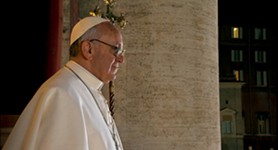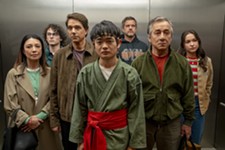
Anselm
2023, NR, 93 min. Directed by Wim Wenders.
REVIEWED By Richard Whittaker, Fri., Jan. 12, 2024
There's a symmetry to Anselm, a documentary tool by which great German filmmaker Wim Wenders explores the creative life of his country's first significant contemporary artist, Anselm Kiefer, a monumental creator whose work stands on a high-wire between purposeful chaos and discovered order. A prodigy with brush and pen at an early age, Kiefer's work now is truly gigantic, as reflected in the growth of his studios, from bedroom to barn to warehouse and now an entire 200-acre complex in the south of France. Warhol used a factory: Kiefer, it is clear as he bicycles around his massive atelier, requires one.
It's arguably of a pair with Wenders' 2012 performance/documentary/obituary Pina, recounting the life and work of great German choreographer Pina Bausch, not least because he once more picks up a 3D camera. No one captures a person wandering aimlessly in wonder through a natural space like Wenders and this being in 3D he gets to indulge his love of long shots down corridors and boulevards (the arthouse documentarian's equivalent to a 3D horror "knife out of the screen" shot).
Instead, he stands back to observe Kiefer: or rather, two areas that clearly fascinate him with Kiefer as an artist. There is the interest in his methodology, captured in how he collects and forms unlikely materials, splattering molten metal and torching grass mudded to canvases, hardening clothes so that they clang on the ground when he casts them from a giant metal staircase, slathering paint on a saber-sized painter's knife over delicately shaded sketches the size of a house. But equally fascinating to Wenders is the philosophy of the artist, who regularly faced criticism for his attempts to wrest millennia of German history from the perversion of the Nazis, all the while refusing to let them bury their own complicity in the Reich's crimes. His extraordinary photographic project, "Occupation," a series of self-portraits of him dressed in his father's Wehrmacht uniform, performing limp-wristed Sieg Heil salutes across Europe, remains as powerful and provocative as it was in 1969. Under Wenders' careful eye it's shown to be as much a part of Kiefer's catalog as his modern, more familiar, more epic concrete constructions - themselves evocative of the bombed-out buildings of Donaueschingen in which he played.
Those questions of midcentury German identity clearly obsess both men, both raised in the wreckage of the Reich, and through his impressionistic depiction of the artist's work Wenders comes to a closer understanding of the melding of medium and muse (much more so than Sophie Fiennes' intriguing and dreamlike 2010 documentary about Kiefer's construction of his Eschaton complex, Over Your Cities Grass Will Grow). Yet Kiefer the man can be oddly absent, and his personal life is generally a blur. It's not until the final credits that you'll realize that the younger Kiefer of several reconstructed scenes is actually the artist's own adult son, Daniel. It's an interesting thought experiment to imagine what that other child of 1945, the perennially nosy and cheerfully intrusive Werner Herzog, would have got out of either Kiefer about their often-challenging relationship. But this is Wenders’ portrait, and as such it is as unique and thought-provoking as Kiefer’s own epic works.
A note to readers: Bold and uncensored, The Austin Chronicle has been Austin’s independent news source for over 40 years, expressing the community’s political and environmental concerns and supporting its active cultural scene. Now more than ever, we need your support to continue supplying Austin with independent, free press. If real news is important to you, please consider making a donation of $5, $10 or whatever you can afford, to help keep our journalism on stands.









